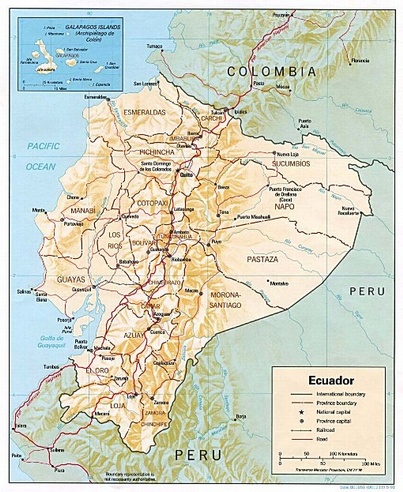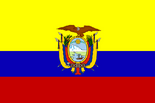





| Quito is the capital of Ecuador and the major transport hub that connects you to most other parts of Ecuador. Quito lies in a long valley at 2800m altitude, so if you come from sealevel don't rush it, since you'll be out of breath in no time. The old city center is the main attraction of the city itself. Some very spacious squares and beautiful churches. Especially La Merced is worth a visit as the interior is one big splash of gold. Most touristaccomodationand night life is a couple of kilometers north of the old city center, which is generally safer at night than the old city center. trolleybus connection are frequent and quick way of traveling between the two parts of town. The couple of times we had to spend a night in Quito when we were traveling from one place in Ecuador to the other we stayed in a a German run B&B with which we booked our Galapagos trip and was conveniently located in between the old city center and the airport. |

| Cajas National Park protects beautiful Paramo and cloudforests wihch is perfect for making treks. We visited the park on a daytrip from Cuenca, leaving very early in the morning, to be able to visit the lower section (3100m) in the morning and the higher part (4000m) in the afternoon. The lower section, called Llaviucu, closest to Cuenca can be reached by bus in 30 minutes. There's a nice lake with some Polylepsis forests surrounding it. This is a great area for birding, such as Grey breasted mountain toucan and Andean Guan. The higher section, called Torreadora, is sparsely vegatated and is characterized by many lakes. It's much colder up there, so bring enhough cloths. There are some niec circular wlks to be made up there, where we saw some intersting birds such as caranculated caracara and Tit-like dacnis. Also this partof the National Park is reachable by bus from Cuenca (1h). |
| Otavalo is just 2 hours away from Quito and definately worth a visit if your want to see one of the biggest markets of the Andes. On saturdays the whole town is just one big market which is not that touristy at all. Of course you can buy some nice souvernirs, but the majority of the stuff on sell is for local people. It's really great just watching local people do their thing, bargaining, buying and selling. The animal market was particularly interesting. Guinea pigs were sold by the hundreds. Apart from the market, the surroundings are also worth visit. Not that far there are several tapestry villages, a beautiful albeit somewhat tourisry waterfall and a bit further away a very scenic volcanic lake, cuicocha, around which one can make a strenous 5 hour circular walk. We can highly recommend this! Also good for birding. |

| Loja is a small version of Cuenca, but not as lively. We stayed there as a jumping point ot visit the Podocarpus National Park. If you are in Loja go to one of the Guinea Pig restaurants where you can eat them grilled and served in one piece: Cuy chactado, the specialty of the region. |

| Cuenca's colonial center is a World heritage site and with good reason. A beautiful cathedral, several other nice churches and leafy squares, make this city a pleasure to stroll through. Furthermore there is a good share of restaurants and bars. There is a very nice museum, Museo del Banco, and a argeological site if you are interested in the Inca history of the city. Cuenca is also known for its Panama hats. Several of these shops can be found in the wdetern part of town. Finally, Cajas national Park and Ingapirca, the biggest and most important Inca ruins of Ecuador, are easily reached from quenca by day excursions. We enjoyed a lot staying there for a couple of days. |

| The cloudforests west of Quito are a brders heaven. Countless endemic species and one of the highest densities of hummingbirds in the world. We visited a community run cloudforest reserve, called Santa-Lucia, which has a couple of cabins situated at the the rim of the mountain range at about 2000m altitude. To get there, one needs to walks about 2 hours uphill, while your belongings are carried by mules. Unfortunately we were only able to stay there for 2 nights. But even then, with the help of Julio, we were able to spot 100 or so bird species, such as Toucan Barbet, numerous Tanager species and Crested and goldenheaded Quetzals. Also the vegatation is beautiful with many orchids and bromelias dangling from trees. One of the star attaractions are the hummingbirds feeders, that sometimes attract more then 10 different species at the same time. You just have sit and wait. Birding couldn't be easier. We can totally recommend this lodge. |

| A big stretch of Paramo, Cloudforest and rainforest on the eastern slopes of the Andes in Southern Ecuador are protected in Podocarpus National Park. It's a birders paradise with close to 600 species identified so far. We visited the park by day trips from Loja. With the very knowledgeable guide Pablo Andrade we visited the lower section near Zamora. Despite the fact that it rained continuously the whole day, we were able to see close to 80 different bird species. Especially the variaty of tanager species is amazing. The next day we visited the higher section of the park (Cajanuma) ourselves. But now the weather was even worse: mist and rain...but what else can you expect from a cloudforest? Nonetheless we were able to see some mountain tanagers and ant-pitta's. So in summary, a beautiful but WET park |
© Bart Everts

 |
 |
 |
 |
 |

| The Ecuadorian lowland rainforest is unfortunately severely fragmented due to logging and oil-drilling. From what is left the eastern most part of the rainforest is now protected by Yasuni and Napo national Parks. This part of the amazon basin has an extremely high biodiversity since it was a refuge for species during the Ice ages, when rainforests recded to a few areas such as eastern Ecuador. The two parks are seperated from each other by the Rio Napo (one of the major tributaries of the Amazon river). alongside the Rio Napo several jungle lodges have been set up, of which we visited the Sani Lodge. It is one of the few lodges that it totally run by local people (the Sani) and all profits go back into the community. Teh staff and the guides are also local people so they know the forests extremely well. The lodge itself is located on a tranquil lake connected to the Rio Napo by a narrow stream. We stayed in the lodge for 5 days, during which we saw around 150 bird species, 6 monkey species and a lot of insects. Especially teh birding was outstanding mainly due to the two bird guides that showed us around. The two brothers, Guillermo and Domingo, were just amazing. The ease with whichthey saw and recognized birds was incredible. Have you oevr seen a Long-atled, common and great Pottoo within half an hour? If you are interested in birds they are the guides you should go for! The birding was also nice because there is a 40m high watchtower and several clay licks close to the lodge that make the birding particualrly rewarding, even if you are not a twitcher. Also a visit to the Sani community in the forest is recommendable. |

| The Galapagos Island need little introduction. A unique set of islands famous for its strange inhabitants both on land in the sea. Visiting the Galapagos is big business. Loads of tourists arrive in several charter planes a day at the airport of Baltra, from where they board one of the 90 or so boats that cruise through the archipel. We visited 10 islands in a week on the Angelito boat. We expected it to be very busy both on the boat and the Islands. But to our pleasant surprise we eventually only had to share the boatthat can take 16 tourists with 4 others. Moreover, the itinerary chosen by th e boat was such that we hardly encountered other tourists on the islands, which was great. There are few places in the world where it is so easy to watch wildlife. The Marine and Land Iguanas, the sealions and boobies are easily approached and my telelens was most of the times totally superfluous. Also under water there was loads to see. Where on earth can you snorkel with pinguins, sea lions, marine iguanas, sharks, turtles and rays? The wildlife experience was just fantastic, not in least because of the very knowledgable guide Diego. And on top of that a perfect boat with very friendly crew, good food and well maintained cabins made this trip worth every penny we paid for it. |

| The most well preserved Inca ruins of Ecuador, Ingapirca are a 2 hours drive north of Cuenca. If you expect to see something comparable with the Peruvian Inca remains, you'll leave the site disappointed. However, despite the fact that only a few walls are actually true Inca remains, the history behindthis place is very interesting. therefore, it's highly recommended to take guide who can explain you all the history and theories of the site. ONe of the interesting features is that half of the site is actually built by the indigenous Canares people, with which the Incas worked together, after finding out they couldn't be subdued. The fact two different cultures worked together to build the site is most evident from the two clearly distinct building styles of the walls that can now be found at the site. to get to Ingapirca take a Caņar-bus from Cuenca that conveniently drops you off at the entrance and returns 2 hours later, giving you enough time to explore the site. |
 |
 |
 |
 |
 |
 |
 |
 |
 |
 |
 |
| Physical activities: eg Walking / Rafting / swimming Nature: eg National Park / Reserve City / Cultural site |
 |

 |











